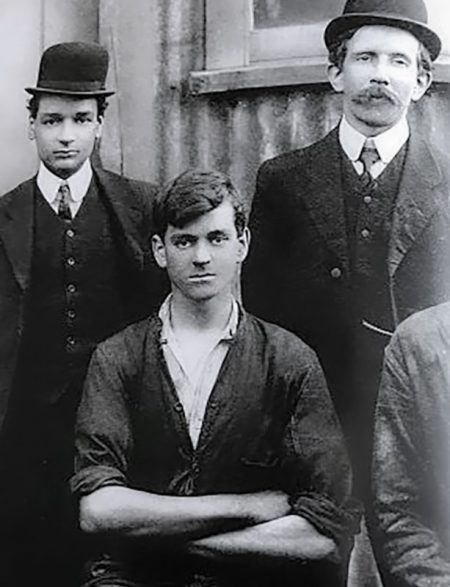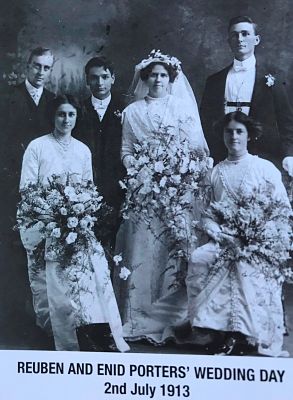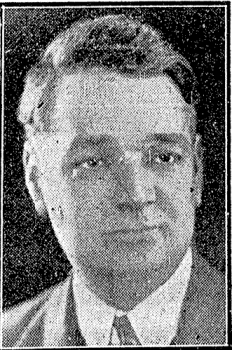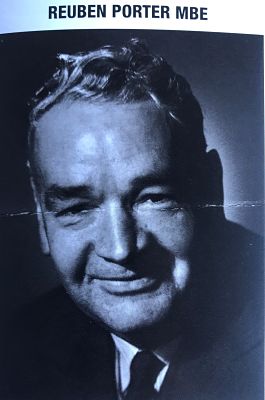Purewa — Reuben Charles Porter
The story begins on 1st December 1910 when three young men, Edwin Jones, Harold Mason and Reuben Porter took over the lease of City Engineering Ltd which was in a dilapidated backstreet tin workshop in the centre of Auckland city.
Reuben and Harold were born in New Zealand; Reuben in Rolleston St, Thames on September 20th 1886. His father Frederick had emigrated to New Zealand with his brother William in the early 1880s The family then moved to Christchurch in 1890 where Frederick Porter went to work for William while his wife opened her own dye and cleaning business.
In 1892 Frederick Porter’s family moved to Auckland opening Porter’s Dye Company in Karangahape Road settling in Mt Eden. Reuben attended Beresford St School and left in December 1903. He became apprenticed to Dunn, Smith & Co which was an engineering business specialising in brass foundry work and ship repairs. He was paid 5/- a week with 6d an hour for overtime and walked to work. Dunn, Smith & Co. was located near the waterfront in Customs Street West. Reuben Porter worked on “fitting and erecting machinery and general repairs”. When A&T Burt Ltd bought Dunn Smith out two years later Reuben Porter moved to AJ Parker and Co. to complete his apprenticeship and worked as a tradesman until he left to go on his overseas experience in 1908. Harold Mason was a founding partner in AJ Parker and Co. and it appears he was mainly involved in administration. There he befriended Reuben Porter even though he was four years younger, but they both had a similar outlook on life.
Harold had married Violet Filmer in 1906 and Harold invited Reuben to accompany him and Violet to the UK to broaden his experience. They returned from the UK in on 24th October 1909, where Violet had given birth to their daughter Agnes. Both men were restless on their return having observed the highly developed engineering industry in Britain. When Reuben learnt that Harold was looking at the possibility of purchasing a small engineering business with Edwin Jones, he offered to join them in partnership. City Engineering opened for business in December 1910, classified as an “iron factory”. Unfortunately Edwin Jones broke his leg and had to withdraw from the business after four months. In the middle of 1911 City Engineering became involved in manufacturing milking machine pumps. Reuben was able to design and manufacture an improved vacuum pump as well as obtaining a patent.
The business began to grow rapidly, requiring a move to new premises in Victoria Lane between Hobson and Nelson Streets. The company was approached by the Gane Milking Machine Company to manufacture their vacuum pumps and it was here that Reuben met Enid Amelia Haszard Barnett who worked in the office at Gane. Reuben and Enid became engaged when she became the first secretary employed at City Engineering in 1912. Enid was the granddaughter of Amelia Jane Haszard who was at the eruption of Mt Tarawera in 1886 when her grandfather Charles and three of their children were killed. Reuben and Enid were married on 2nd July 1913 at the Epsom Baptist Church and moved into 15 Mason’s Avenue in Herne Bay, which her grandmother had made available for Enid and Reuben.
Reuben worked on developing and building a new 4 cylinder marine engine which was used in various motor boats over the years. The experience that Reuben Porter and Smith had gained in making marine engines led them to consider making oil engines for farm use.
1914 was a very busy year with both Reuben and Harold Mason falling ill from overwork, Reuben being diagnosed with meningitis and only recovering his health and the business with Enid’s help. In 1915 City Engineering suffered a setback when it lost the contract for the manufacture of vacuum pumps to Gane Milking Machine Company which had got into financial difficulty. World War One did not help as there were staff shortages on the foundry floor and then the influenza epidemic. Harold Mason had taken over the administrative side and Reuben the manufacturing side of the business. So in October 1916 in order to keep afloat they became a company called Mason and Porter with help from Robert Laird, a “smart business man”, who designed an oil engine and other Masport engines.
At the same time they moved the business to Cleveland Road, Parnell. In 1919 Captain Smith and Robert Laird both withdrew from the business, while Colonel White became a director having injected £2,000 into the business. During the war, the Porters had three children, Mona in 1915, Fred in 1917 and Ruth in 1919. The 1920s saw a change in direction as dairy farms installed electricity to drive their milking machines. The company undertook a range of work from motor reconditioning to repairing castings on tramways to manufacturing water pipes for Auckland City Council. Staff numbers grew to 24 in the 1920s. Harold Mason had to resign in 1926 due to continued ill health and Enid Porter returned to run the administrative side of the business, but in 1929 the prototype Masport RAPID lawn mower was produced. The firm produced high quality ornamental window mullions and grilles for the Smith and Caughey building and for the Auckland War Memorial Museum. The Brass Foundry was made separate from the Iron Foundry in expanded premises at Cleveland Road. With Enid having sorted out the office systems and restructured the costings, Reuben concluded that a more secure future would be obtained by mass production of a product for the public.
It was noted that the American and British imported lawn mowers were of poor quality and subject to a 40% import tax. In spite of the Depression, the RAPID hand lawn mower was built and taken to the market in1930 with great success in the 1930s. By the start of World War Two in 1939 the company had grown considerably, a women’s workforce section was added and the N Z Government contracted Mason & Porter to be its sole supplier of mowers. The Gill Estate in Mt Wellington was purchased as new premises for the firm in 1939 and a brand new factory and plant were built.
WW2 also saw chronic labour shortages but with its female workforce and recruitment of older workers, Mason & Porter was very busy with war work. Reuben Porter was appointed Chairman of the Joint Allocation Committee set up to repair and build ships for the United States Army and Navy in the Pacific and adapted to the manufacture of military hardware. After the war, Reuben received an M.B.E in recognition of his war work.
By 1946 Reuben Porter was turning 60 and then his wife Enid died unexpectedly on a trip to Christchurch. The loss of her business acumen and administrative skills were acutely felt by Reuben and the company. Mason & Porter worked on developing motor mowers through the 1940s. The 1950s saw the transfer of the general management of the business from Reuben to his son Fred – both were very hands-on practitioners and left the administrative side to others after Enid’s death. By 1950 Reuben retired as Managing Director and became Chairman of the Board. The 1950s were significant for the successful introduction of the ROTACUT motor mower at the Mt Wellington plant. In 1958 company sales hit £1,000,000 for the first time, with motor mowers making up 60% of all sales. 1961 saw the introduction of the ROLAMOWER which again proved to be a runaway success with the New Zealand public.
Reuben Porter died on 4th October 1964, aged 78 years. He was known as a sincere and humble man who liked nothing better than to “do a bit of turning” on a lathe. He was innovative, hard-working and entrepreneurial but still looked after the welfare of his staff while never forgetting his working class origins. He was a leader of his time through the growth of New Zealand’s industrial design and manufacturing. Reuben Porter is buried at Purewa Cemetery Block A Row 14 Plot 93C.



